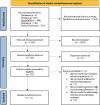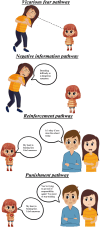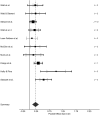The Association Between Parent-to-Child Fear Learning Pathways and Anxiety Sensitivity: A Systematic Review and Meta-analysis
- PMID: 40254673
- PMCID: PMC12162801
- DOI: 10.1007/s10567-025-00517-7
The Association Between Parent-to-Child Fear Learning Pathways and Anxiety Sensitivity: A Systematic Review and Meta-analysis
Abstract
Although anxiety sensitivity (AS), or the fear of anxiety-related symptoms, has been identified as a risk factor for the development of anxiety psychopathology, the pathways through which this fear is learned have not been fully elucidated. In the current review and meta-analysis, we aimed to systematically examine the association between parent-to-child fear learning pathways (vicarious learning, negative information, reinforcement, and punishment) and AS. A comprehensive search of literature was conducted in PsychINFO, PubMed, Embase, and Web of Science databases, using search terms combining categories related to fear learning pathways, anxiety-related symptoms, parents, children, and adolescents. Based on this search strategy, 28 studies were identified as relevant, of which 11 were included in the systematic review and 10 in the meta-analysis. The overall findings indicated that parent-to-child fear learning pathways are significantly associated with AS. The meta-analysis demonstrated a small but significant association between fear learning pathways and AS, although the type of fear learning pathway did not significantly moderate this relationship. However, age emerged as a significant moderator, suggesting a stronger association in children and adolescents compared to adults. Given that these findings are primarily based on cross-sectional studies, this review underscores the need for longitudinal and experimental research to further clarify the role of parent-to-child fear learning pathways in anxiety sensitivity. Additionally, a better understanding of these pathways may help inform existing interventions and fear prevention strategies, such as those aimed at reducing parental modeling of fearful behaviors or promoting positive verbal messages about anxiety symptoms.
Keywords: Anxiety sensitivity; Fear; Learning pathway; Meta-analysis; Systematic review.
© 2025. The Author(s).
Conflict of interest statement
Declarations. Conflict of interest: The authors declare that the research was conducted in the absence of any commercial or financial relationships that could be construed as potential conflict of interest. Ethical approval: This review synthesizes existing research and is based on analysis of previously published data. It did not involve the collection or manipulation of published data. The review adheres to ethical guidelines and principles, and all data and findings are presented accurately and without bias.
Figures




Similar articles
-
Systemic pharmacological treatments for chronic plaque psoriasis: a network meta-analysis.Cochrane Database Syst Rev. 2021 Apr 19;4(4):CD011535. doi: 10.1002/14651858.CD011535.pub4. Cochrane Database Syst Rev. 2021. Update in: Cochrane Database Syst Rev. 2022 May 23;5:CD011535. doi: 10.1002/14651858.CD011535.pub5. PMID: 33871055 Free PMC article. Updated.
-
Systemic pharmacological treatments for chronic plaque psoriasis: a network meta-analysis.Cochrane Database Syst Rev. 2020 Jan 9;1(1):CD011535. doi: 10.1002/14651858.CD011535.pub3. Cochrane Database Syst Rev. 2020. Update in: Cochrane Database Syst Rev. 2021 Apr 19;4:CD011535. doi: 10.1002/14651858.CD011535.pub4. PMID: 31917873 Free PMC article. Updated.
-
Parent training interventions for Attention Deficit Hyperactivity Disorder (ADHD) in children aged 5 to 18 years.Cochrane Database Syst Rev. 2011 Dec 7;2011(12):CD003018. doi: 10.1002/14651858.CD003018.pub3. Cochrane Database Syst Rev. 2011. PMID: 22161373 Free PMC article.
-
Behavioral interventions to reduce risk for sexual transmission of HIV among men who have sex with men.Cochrane Database Syst Rev. 2008 Jul 16;(3):CD001230. doi: 10.1002/14651858.CD001230.pub2. Cochrane Database Syst Rev. 2008. PMID: 18646068
-
Systemic pharmacological treatments for chronic plaque psoriasis: a network meta-analysis.Cochrane Database Syst Rev. 2017 Dec 22;12(12):CD011535. doi: 10.1002/14651858.CD011535.pub2. Cochrane Database Syst Rev. 2017. Update in: Cochrane Database Syst Rev. 2020 Jan 9;1:CD011535. doi: 10.1002/14651858.CD011535.pub3. PMID: 29271481 Free PMC article. Updated.
References
-
- Adornetto, C., Hensdiek, M., Meyer, A., In-Albon, T., Federer, M., & Schneider, S. (2008). The factor structure of the childhood anxiety sensitivity index in German children. Journal of Behavior Therapy and Experimental Psychiatry,39(4), 404–416. 10.1016/j.jbtep.2008.01.001 - PubMed
-
- Allen, K. B., Tan, P. Z., Sullivan, J. A., Baumgardner, M., Hunter, H., & Glovak, S. N. (2023). An integrative model of youth anxiety: Cognitive-affective processes and parenting in developmental context. Clinical Child and Family Psychology Review,26(4), 1025–1051. 10.1007/s10567-023-00458-z - PubMed
Publication types
MeSH terms
LinkOut - more resources
Full Text Sources
Medical
Research Materials

